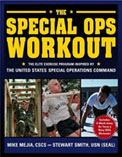Meet Stew | Testimonials | YouTube Videos | List of Articles | Favorite APP Workouts | FREE Workouts | Contact / Newsletter
Interval Workouts - Running Training for Speed
Last week, I
received an email asking if interval training was a good way to improve
speed in your military PFT run. The answer is
absolutely. But what exactly is interval
training and how do I determine what speed I should train? the question
continued.
There are some general formulas that can help you determine where you should
be, but I personally like to use the following method of determining
interval workout components that include: Distance, Run and Rest Interval,
Repetitions, and Time. Each of these components of interval training effect
the other as noted below.
I do not use a general calculating formula but a more specific running
approach, since we all are different types of runners. For example, a runner
runs the USMC 3 mile in a 21:00 that is a 7:00 mile pace. To get a perfect
score on the USMC run, one has to run an 18:00 time that is a 6:00 mile
pace. How do you get to be a better runner so you can drop three minutes off
your run time?
Follow the steps outlined below and you will have an idea of how to
integrate interval training into your regime:
1) Time yourself in your PFT run.
-
Navy, Coast Guard and Air Force use the 1.5-mile distance.
-
Army uses the 2-mile distance.
-
Marines use the 3-mile distance
2) Determine a
reasonable goal for your PFT run.
3) Find your GOAL time for the PFT run. Divide your goal to figure out the
mile pace
4) Divide your mile goal pace into 1/8-mile, 1/4-mile, 1/2-mile distances
The following distances are great for any of the military PFT run interval
training and the times listed below will help our sample runner decrease his
run time to a 6:00 mile.
For instance the USMC runner should train at:
-
1/2-mile times should be run in 3:00
-
1/4-mile times should be run 90 seconds, and
-
1/8-mile times should be run 45 seconds
It is
recommended to either walk or slowly jog as a recovery method in between the
timed runs above. The interval of rest depends on your fitness level. Walk
to rest if you are a beginner or average runner and jog to catch your breath
if you are more advanced. Usually the walking distance is equal to or 1/2
the distance you just ran. So, if you ran a 3:00 1/2-mile, walk or slow jog
a 1/4-mile. NOW you know your pace at each distance...time for the workout!
Putting all the components of interval training together creates a
challenging workout that will help you decrease your PFT run time:
-
Repeat 3-4 times
-
Run 1/2-mile at goal pace
-
Walk or jog 1/4-mile
Repeat 4-6 times -
Run 1/4-mile at goal pace
-
Walk or jog 1/8 of a mile
-
Repeat 4-6 times
-
Run 1/8-mile at goal pace
-
Walk or jog 100 yds
Do this workout
two times a week combined with two longer runs of three to five miles during
the week. In a few weeks, you will see your running pace increase and your
mile times begin to drop while making your pace easier to maintain. Here are
a few more tips to help you pick up your pace and stay injury free:
1) Breathing - Take big, deep inhalations and exhalations similar to the way
you yawn. This will help you receive the oxygen your body needs. Slow down
the running pace if you need to, but concentrate on your breathing.
2) Stride and Heel / Toe Contact - Open your stride to a point
where you will land on foot close to your ball of your foot - NOT the heel) and roll across your foot, pushing off the ground
with your toes. You can eliminate this by following the simple Audio Test.
If you can hear your feet hitting the ground when you run, then you are
running wrong. It should sound like your shoes are rolling on the ground
quietly. Comfortable running shoes will also aid in prevention of injuries.
3) Arm Swing - You should have a relaxed arm swing but very pronounced.
Swing your hands from about chest high to just past your hips in a straight
line. The term "hip to lip" is a good way to remember this when you are
running. Your arms should be slightly bent but not flexed.
4) Relaxed Upper body - You should relax your fists, arms, shoulders, and
face. This causes the oxygenated blood that you need to go to your legs to
also go to your upper body. The only things that need to be working when you
are running are your "lungs and your legs."
5) Start slowly and warm up - Do not stretch your legs until you have warmed
up your body by jogging or biking slowly for about 5-10 minutes. Run every
other day if you are just beginning and only add mileage to your run as you
feel comfortable.
Good luck with your running program and I hope you see improvement soon.
These workouts and others can be easily obtained at the
StewSmith.com Fitness Ebook Store. Send me an email and I may post it up as
an article next week. You can contact me at
stew@stewsmith.com.
| Links to Stew Smith eBooks |
 Stew Smith is a former Navy SEAL and fitness author
certified as a Strength and Conditioning Specialist (CSCS) with the National
Strength and Conditioning Association. If you are interested in starting a
workout program to create a healthy lifestyle - check out the StewSmith.com
Fitness eBook store and the
Stew Smith is a former Navy SEAL and fitness author
certified as a Strength and Conditioning Specialist (CSCS) with the National
Strength and Conditioning Association. If you are interested in starting a
workout program to create a healthy lifestyle - check out the StewSmith.com
Fitness eBook store and the
Stew Smith article archive at StewSmith.com. To contact
Stew with your comments and questions, e-mail him at
stew@stewsmith.com.

















